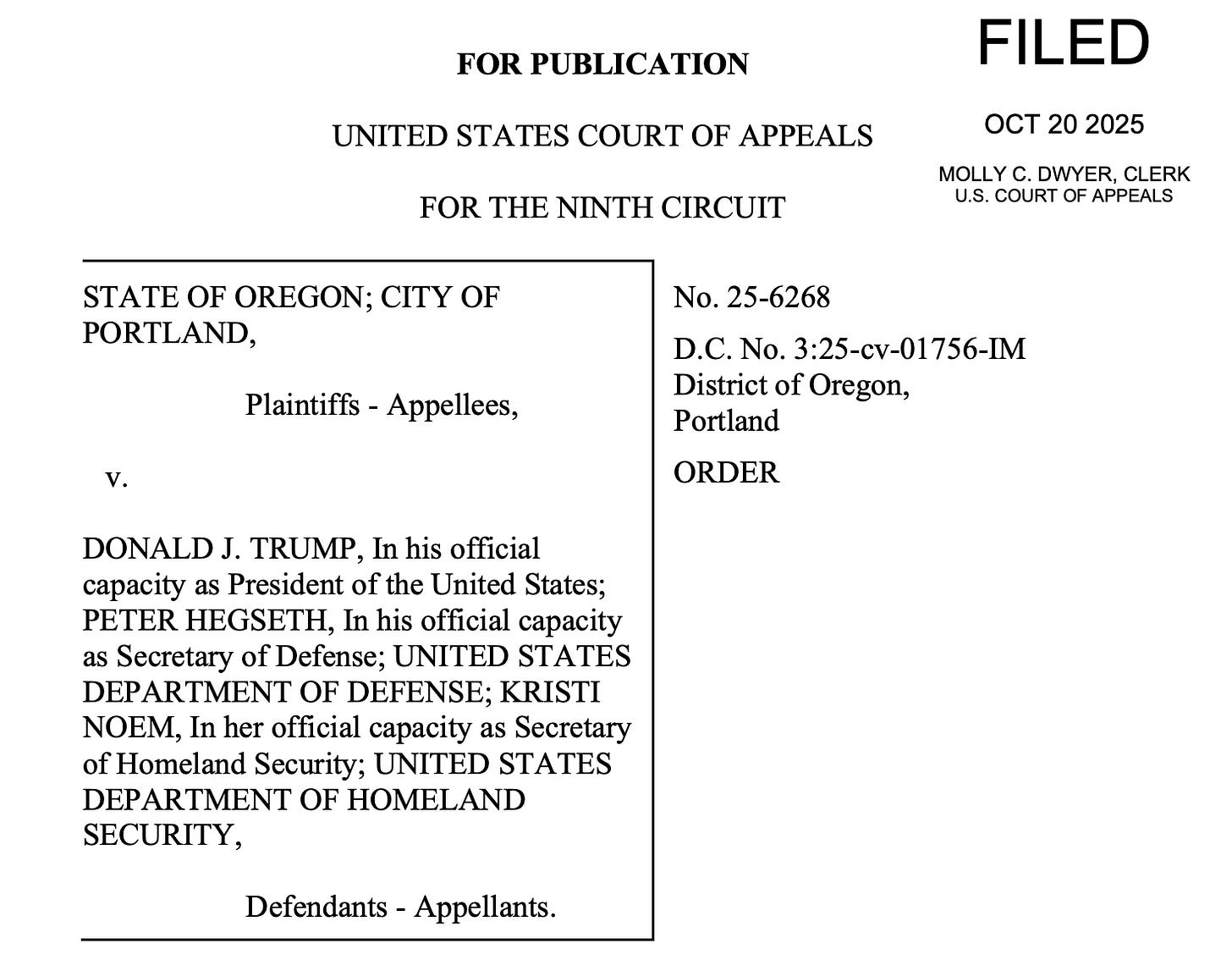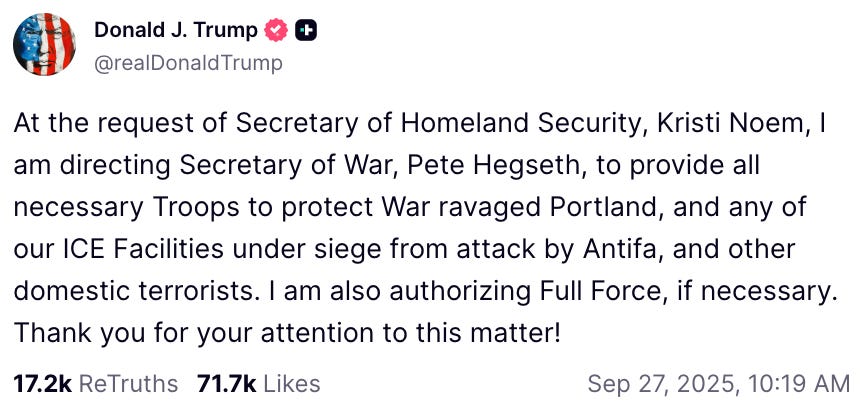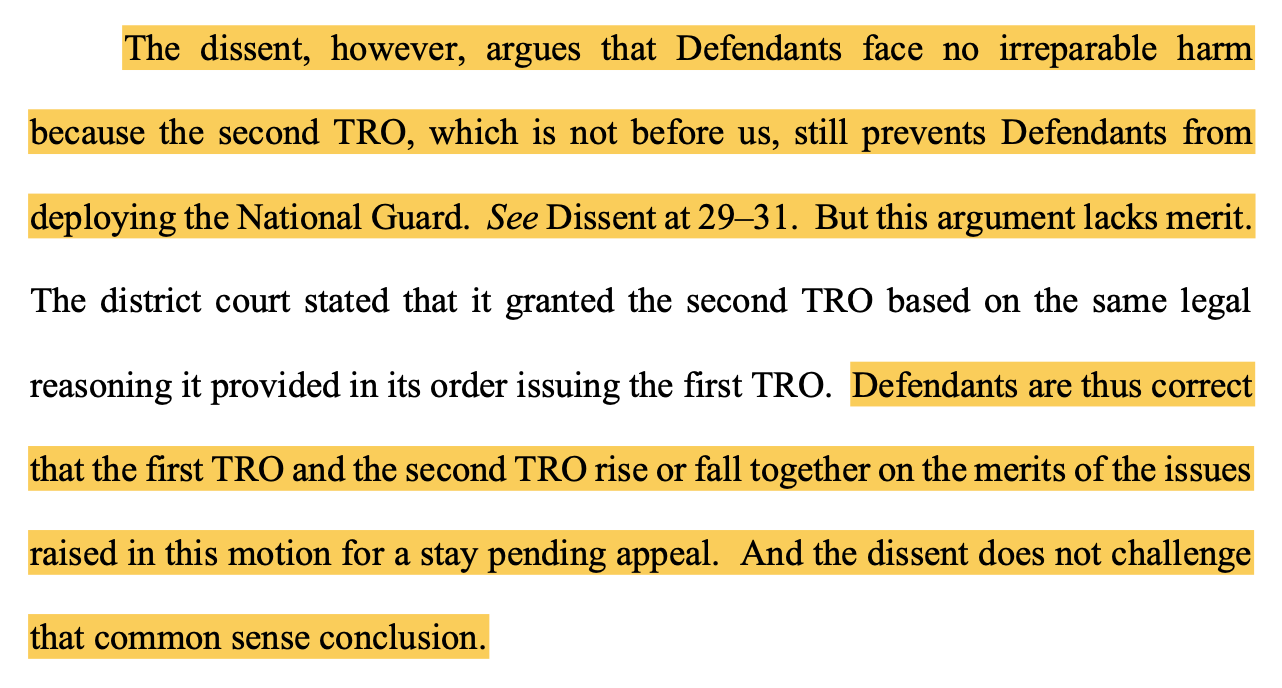The Ninth Circuit's 2-1 Oregon National Guard order was just the start of getting to an answer
Monday's order granting the Trump admin a stay pending appeal in the Oregon case changed nothing on the ground immediately. But, it did crystallize where we are at — and going.
On Monday afternoon, a three-judge panel of the U.S. Court of Appeals for the Ninth Circuit issued a 2-1 order that the majority believed would allow President Donald Trump to deploy members of the National Guard in Portland, Oregon.
It was both an alarming order issued on behalf of two Trump appointees that would expand the scope of Trump’s powers and a potentially short-lived order that changed nothing on the ground in Portland immediately.
Quoting from the earlier Ninth Circuit order preliminarily siding with the Trump administration in its defense of its Los Angeles deployment of the National Guard, the unsigned opinion from the majority on Monday held that “[t]he evidence the President relied on” in the Portland federalization decision “reflects a ‘colorable assessment of the facts and law within a range of honest judgment.’“
Both judges in the majority, Judges Bridget Bade and Ryan Nelson, were appointed to the appeals court by Trump in his first term and were skeptical of the district court’s TRO at arguments earlier this month.
Judge Susan Graber, a Clinton appointee, “strenuously” dissented. In addition to disagreeing with the reasoning of the majority’s order, however, she explicitly urged her Ninth Circuit colleagues to “vacate” this panel’s decision quickly and wrote that the majority’s order does not even necessarily mean the National Guard will able to be deployed — due to a litigation decision by the Justice Department not to appeal a second, broader TRO in the Oregon case.
Less than two hours later, the Ninth Circuit announced that a judge on the appeals court had already requested a vote on whether the court should reconsider the matter en banc.
The Oregon v. Trump order on Monday highlighted, at best, the extremely dysfunctional nature of our judiciary in this moment. It also was issued at a key moment, as the courts move toward more definitively resolving whether Trump can use the National Guard in American cities as he is seeking to do — and what limits, if any, will attach to that use.
What is happening?
There are four important things to know to understand Monday’s order:
What Monday’s Ninth Circuit order is;
The context in which it was issued;
What the order isn’t; and
What happens next.
Let’s take them one by one.
What is the order?
The order is a stay of the temporary restraining order against federalizing the Oregon National Guard that was issued by U.S. District Judge Karin Immergut, a Trump appointee, on October 4 and extended on October 15 for an additional 14 days.
The per curiam order for the court was issued on behalf of Bade and Nelson. Nelson also wrote a concurring opinion that would go even further toward giving Trump unreviewable authority when it comes to sending troops into American cities. And, it also contained Graber’s sharp dissent.
The order first finds that although TROs are not generally appealable, this one is because the TRO has “the practical effect of a preliminary injunction.“ Oregon’s lawyers argued that, unlike the California-related order in Newsom v. Trump, this TRO should not be appealable “based on the duration of the TRO.“ The Ninth Circuit panel’s majority inexplicably argued that because Immergut extended the TRO once for a second 14-day period, “[t]he TRO here will be in force for more than the presumptive 14-day period of Rule 65, and Plaintiffs’ argument to distinguish Newsom on this basis fails.“
This is the relevant portion of Rule 65, which, you will see, explicitly contemplates an extension of the “14-day period” in the very same sentence where the 14-day period is described:
This is carelessness, at best.
The “factual background” — essentially a rundown of everything the Trump administration has claimed even concerned them anywhere in order to backfill and justify Trump’s decision to send the National Guard to Portland via Truth social post on September 27 — is embarrassingly one-sided in light of the very Ninth Circuit Newsom decision that the panel purported to be applying.
As such, we get portions like this:
On September 19, HSI received a tip that someone planned to detonate a bomb at the ICE facility that day. Wamsley Decl. ¶ 14. Although the threatened attack did not occur, preparing for the possibility required an increase in security inspections and diverted important agency resources. Id.
Ultimately, as the panel turned to the central question — the likelihood of success on the merits — the majority was unhappy that Judge Immergut … judged the matter before her.
Noting the Newsom standard of whether the president’s decision under 10 U.S.C. 12406 that he was “unable with the regular forces to execute the laws of the United States,” “reflects a colorable assessment of the facts and law within a ‘range of honest judgment,’” the panel majority’s order on Monday stated regarding Immergut’s order:
Rather than reviewing the President’s determination with great deference, the district court substituted its own determination of the relevant facts and circumstances. That approach is error under Newsom.
I honestly am not certain how one reviews whether a presidential determination “reflects a colorable assessment of the facts and law within a range of honest judgment” without looking at “the relevant facts and circumstances” under the law at issue and then making a “determination” — it’s better known as a ruling — of whether the presidential decision meets that standard.
That is not substituting determinations; it is judging. It is wordplay by the majority that demeans a district court colleague who determined, on the record before her court, that Trump’s “determination was simply untethered to the facts.“
After going through the other factors for granting a stay, one of which I will discuss more below, the majority issued the stay of the October 4 TRO pending appeal.
What is the context?
Three notable other happenings provide context for Monday’s order.
Perhaps most importantly, it came as the U.S. Supreme Court is considering the Justice Department’s request for a stay pending appeal of a TRO issued barring National Guard deployment in Illinois. The U.S. Court of Appeals for the Seventh Circuit denied DOJ’s request for a stay of that TRO, and DOJ went to the Supreme Court on October 17.
The Ninth Circuit order came hours before the response to that request was due at the Supreme Court, and DOJ is certain to reference the Ninth Circuit order in its reply.
The order in the Oregon case also came two days before the Ninth Circuit is set to hold merits arguments in the appeal of the order in Newsom v. Trump. (The earlier order was, like Monday’s order, a stay pending appeal.)
Finally, the order came as trial preparations are underway before Immergut. The district court is working fastidiously to move the case toward final resolution, with trial set to begin October 29. In other words, despite DOJ’s request and the way majority on Monday reached down to decide this TRO stay request, Immergut was preparing a way to get this case to the Ninth Circuit — properly — on a very quick timetable.
What was the order not?
The order was not Nelson’s concurring opinion, which would have got much further toward empowering Trump. As such, it is likely that Bade wrote or at least controlled the limits of the per curiam order.
Nelson wrote separately to lay out his position on four points:
First, under current Supreme Court precedent, presidential determinations under § 12406 are not reviewable by federal courts. Second, Plaintiffs have serious standing issues because they only seek injunctive relief that this court lacks the power to issue and Plaintiffs lack an injury in fact. Third, while the Per Curiam order takes a more fact bound approach to the issues presented, the President’s determination under § 12406(3) and § 12406(2) are bolstered by the history and tradition of the early Militia Acts. Fourth, the likely lawfulness of the President’s determination under § 12406 is bolstered by the executive’s proportionate response to the events in Portland.
The first two are foreclosed, at least at this stage of litigation, by the Ninth Circuit’s Newsom decision, and the second two are Nelson’s musings on why, in his view, history and a barely comprehensible “proportionate response” standard “bolster” his view that Trump can do virtually anything under the law in question.
His standing argument typifies his extremism. Because the alleged violation under 10 U.S.C. 12406 would be a violation of federal law, Nelson wrote, “[A]n illegal federalization and deployment may cause an injury in fact against Congress, but not the states.“
This concurring opinion is error-ridden, careless, and extremist — but it is written only for himself.
While Nelson’s concurrence should not be ignored, there is another factor to understand about what the order is not that is more central to understanding what happened on Monday. The order did not have anything to do with the second TRO issued by Judge Immergut — the order banning deployment of any National Guard in Oregon, including both the Oregon National Guard and California National Guard — which was also extended for a second 14 days on October 15.1
This is one of the areas where Graber most sharply called out her colleagues in her dissent — and the reason why the order, beyond the possibility of further review from the Ninth Circuit, changed nothing immediately.
DOJ never appealed the second TRO.
As Graber explained, this meant DOJ could not show the Trump administration would face irreparable harm if its request for a stay of the first TRO pending its appeal was denied.
“The government has not appealed the second TRO, so a stay pending appeal [of the first TRO] will not have any immediate practical effect,” she wrote. “The government will remain barred from deploying the National Guard.”
To that, the majority wrote:
Graber responded to that at length, however, noting both that this was only a decision about the “likely” success of the Trump administration’s appeal and that “although the district court granted the second TRO in part for the same reasons that it had granted the first TRO, the motion for a second TRO raised additional issues and involved an additional party, and the district court granted the second TRO also in part because of ‘the newly submitted declarations.’“
Then, noting the possible path ahead, Graber wrote:
If the district court entertains a motion to dissolve the second TRO, the court may decide to keep that order in place: either because the court remains convinced of its original reasoning despite the majority’s prediction that the government will prevail in this appeal, or because other reasons support the TRO, or both.
This is a shocking sentence — laying out an explicit path for the district court to reach an alternative conclusion regarding the second TRO than the majority clearly expected.
Then, Graber turned to those colleagues:
“Not so.“
What comes now?
Due to the Ninth Circuit’s large number of active judges — 29 judges, 16 Democratic appointees and 13 Republican appointees — the court employs a “limited en banc” practice, in which the chief judge (currently Judge Mary Murguia, an Obama appointee) and 10 randomly assigned judges rehear a case if the active judges vote to rehear it en banc. Because Graber is a senior status judge, she will not have a vote on whether the case is reheard, but, if the case is reheard, she will be added to the judges eligible to sit on the en banc panel.
Under Monday afternoon’s order, the responses to the en banc vote call must be filed “on or before midnight, Pacific Time, Wednesday, October 22, 2025.“ I know what that actually means — a minute after 11:59 p.m. PT Tuesday — but I am not certain what that means in Judge Sidney Thomas’s mind (or by Ninth Circuit practice).
The second question is what happens before Immergut. Under that October 15 order in which the district court extended the TROs, the court also ordered, “Upon the Ninth Circuit’s issuance of an order on Defendants’ emergency motion to stay, Defendants agreed to file any motion to dissolve the Second TRO within 48 hours, and this Court ORDERS Plaintiffs to respond to Defendants’ motion within 24 hours of Defendants’ filing of the motion.“
DOJ already, before 5 p.m. PT Monday, filed that motion to dissolve or stay the second TRO, so, under Immergut’s order, Oregon’s response is due before then Tuesday.
Monday’s order was important. But, it was more important for the role it is now playing in moving all of these other pieces forward — one or more of which will determine whether there are limits on Trump’s desired use of the National Guard in American cities and how real those limits actually are in practice.
This sentence was corrected after initial publication as I had conflated the states involved, with the final update at 10:30 a.m.








![12 For reasons that escape me, the majority’s order states that I “do[] not challenge” the conclusion that “the first TRO and the second TRO rise or fall together on the merits of the issues raised in this motion for a stay pending appeal.” Order at 34. Not so. As explained in text, the issues raised in this motion for a stay pending appeal include the government’s likelihood of success on its challenge to the district court’s grant of the first TRO. Nothing in the majority’s order does—or cou 12 For reasons that escape me, the majority’s order states that I “do[] not challenge” the conclusion that “the first TRO and the second TRO rise or fall together on the merits of the issues raised in this motion for a stay pending appeal.” Order at 34. Not so. As explained in text, the issues raised in this motion for a stay pending appeal include the government’s likelihood of success on its challenge to the district court’s grant of the first TRO. Nothing in the majority’s order does—or cou](https://substackcdn.com/image/fetch/$s_!9CcG!,w_1456,c_limit,f_auto,q_auto:good,fl_progressive:steep/https%3A%2F%2Fsubstack-post-media.s3.amazonaws.com%2Fpublic%2Fimages%2Fe7b1fd39-99a9-4bcd-93da-65e4b9df0144_1252x364.png)
What a relief to know that the presence of the National Guard would prevent the irreparable harm caused by such time-wasting activities as responding to tips about possible bombs because……uh, because the Oregon National Guard is uniquely gifted with the power to quell the waves that carry phone calls? Must be all the herbal tea.
It isn’t just DOJ that is untethered from reality. Increasingly certain federal judges are, too. Has RFuK determined whether this is caused by Tylenol or circumcision?
Guess The Donald can try to rig more than elections. The law is, apparently, whatever the mercurial favors this moment.